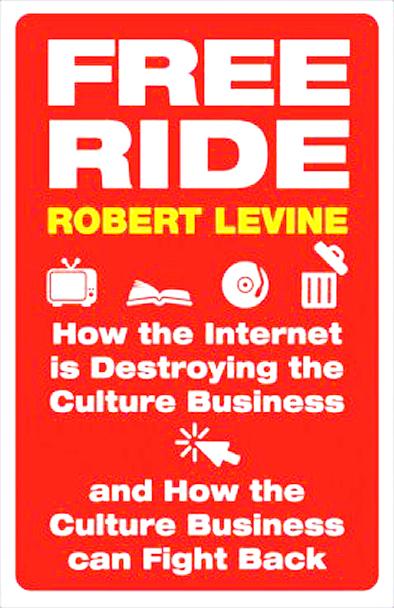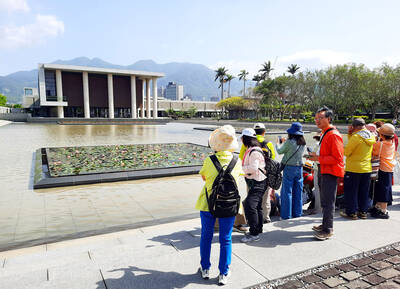When Andrew Keen’s The Cult of the Amateur: How Today’s Internet is Killing Our Culture and Assaulting our Economy appeared in 2007, its subtitle was music to many ears. Short on facts and long on hyperbole, it wasn’t very persuasive, but by then the growing fear that elite culture was capitulating to the vulgar ephemera of pokes and tweets had turned Internet-bashing into something of a cult itself.
In Free Ride, Robert Levine, a one-time executive editor of Billboard magazine, makes a much stronger case for an impending cultural apocalypse. And while he occasionally ventures into the Andrew Keen territory — “this isn’t creative destruction; it’s the destruction of creativity” — he also knows his statistics.
According to Levine, the Web took the culture industry by surprise. Technology companies, on the other hand, were better prepared, exploiting the ensuing confusion to lobby for favorable laws. Levine singles out America’s Digital Millennium Copyright Act, which ensures that sites such as YouTube don’t have to pre-screen every uploaded video for possible copyright violations. Real trouble began when services such as Napster threatened too many business models by allowing users to swap files. Worse, a formidable intellectual lobby — spearheaded by law professors such as Larry Lessig and funded by Silicon Valley — tried to rationalize such activities under the “free culture” banner.

Levine is not exactly a “free culture” man. He argues that faddish ideas celebrated by Internet gurus — for instance, that newspapers should give away their online content — are based on sloppy economics. “For media companies, getting advice from technology pundits was like letting the fox lead a strategic management retreat in the henhouse,” he writes.
‘FREE CULTURE’ IDEOLOGY
Levine is an engaging, provocative writer, and there is much to like about Free Ride. His basic insight, that Silicon Valley’s penchant for experimentation may inadvertently hurt the culture industry, is correct. His materialistic — almost Marxist — explanation of the “free culture” ideology as the product of Silicon Valley’s covert agenda is also quite refreshing.
However, Levine’s penchant for the conspiratorial — everything eventually leads to Google! — is a distraction that occasionally makes him sound like broadcaster Glenn Beck. Most likely, he would dismiss the present reviewer — a fellow at the New America Foundation and Stanford University, both of which take quite a drubbing in Free Ride — as shilling for Google. (Regrettably, I am yet to receive a Christmas card from Eric Schmidt.)
While it’s true that Google has been aggressively shaping Internet policy, this doesn’t mean that its interests always diverge from those of the public. To take an obvious example: Google is funding work on circumventing Internet censorship — the more people browse the Web, the better it is for Google. Is it reasonable to attack such efforts on the grounds that Google has a commercial agenda?
In mounting his passionate attack on Silicon Valley, Levine often distorts the arguments of his opponents. I have yet to meet anyone who subscribes to the theory that “the price of any good should fall to its marginal cost.” Levine believes that Wired’s Chris Anderson wrote just that in his 2009 book Free. But he didn’t: Anderson was writing about firms selling homogeneous and undifferentiated products, not songs or movies. (Anderson: “If one product is vastly superior to another ... the primary determinant of price is not marginal cost but ‘marginal utility’ — what it’s worth to you.”)
Or take a recent study funded by the Knight Foundation, which is blasted by Levine for taking the simplistic view that universal broadband is the way to solve many of journalism’s ills. Those ills, according to Levine, should be addressed by generating more high-quality content — precisely what the Knight study said in five of its 10 recommendations.
While Levine acknowledges the murky nature of most studies about piracy, the studies he does cite paint a more ambiguous picture than he lets on. He touts a 2010 report showing that a quarter of all Web traffic is piracy-related, but he neglects to mention that the report also found that films that could be purchased and legally viewed online are pirated far less often. Hence his assertion that “traditional media companies are in trouble because they’re not giving consumers what they want” does not ring true.
Levine’s call to arms — “it’s time to ask, seriously, whether the culture business as we know it can survive the digital age” — betrays a poor grasp of media history. Had our laws been crafted to preserve the “culture business as we know it”, the photograph, the gramophone, the photocopier, the tape recorder and, yes, the Internet may have never arrived.
In a chapter subtitled “How the Internet could kill Mad Men,” Levine frets about the future of cable television, seemingly unaware of the fact that, back in the 1960s, American broadcast networks did their best to wipe out the nascent cable industry, which survived only thanks to a ruling by the US supreme court. Had the judges followed Levine’s conservative logic, a more fitting subtitle would be “How the networks aborted the parents of Mad Men.”
Are new technologies really that much of a threat to the culture industry? Google TV — one of the projects Levine lists among the greatest threats to cable television — seems dead on arrival; at the moment, product returns outnumber sales. According to a recent survey by BookStats, last year the publishing industry earned nearly 6 percent more revenue than in 2008, while selling 4 percent more books — in part, thanks to e-books. Streaming services such as Netflix and Spotify has made piracy less appealing.
None of this excites Levine, who complains that the Internet has not encouraged innovation. “Like TV, the Internet is only as good as what’s on,” he writes. Statements like this underscore the danger of setting Internet policy based on the interests of the content industry alone. For those in this group, the Internet is merely TV on steroids — its impact on the Arab spring, economic and human development and the future of learning be damned.
TAKING CAUTION
However, it is irresponsible to craft effective Internet policy without examining how it will affect areas that have nothing to do with culture. Do we really want to build tools to screen online content for copyright violations, only to discover that dictators use those very tools for spying on dissidents?
Levine’s proposed solutions are not new. He wants to rewrite or reinterpret laws that shield Internet companies from responsibility for the acts of their users, and enact new laws to punish both publishers and consumers of pirated materials. All of these proposals are likely to trigger unintended consequences — increased surveillance, stalled innovation and disruption of Internet architecture — that Levine prefers not to dwell on.
Despite these shortcomings, Free Ride is still an entertaining read, with an entertaining cast. After all, how often does one get to hear James Murdoch — whom Levine places among the “saviors of journalism” — demanding “an enforcement agenda that works and doesn’t turn a blind eye to theft”?

When the South Vietnamese capital of Saigon fell to the North Vietnamese forces 50 years ago this week, it prompted a mass exodus of some 2 million people — hundreds of thousands fleeing perilously on small boats across open water to escape the communist regime. Many ultimately settled in Southern California’s Orange County in an area now known as “Little Saigon,” not far from Marine Corps Base Camp Pendleton, where the first refugees were airlifted upon reaching the US. The diaspora now also has significant populations in Virginia, Texas and Washington state, as well as in countries including France and Australia.

On April 17, Chinese Nationalist Party (KMT) Chairman Eric Chu (朱立倫) launched a bold campaign to revive and revitalize the KMT base by calling for an impromptu rally at the Taipei prosecutor’s offices to protest recent arrests of KMT recall campaigners over allegations of forgery and fraud involving signatures of dead voters. The protest had no time to apply for permits and was illegal, but that played into the sense of opposition grievance at alleged weaponization of the judiciary by the Democratic Progressive Party (DPP) to “annihilate” the opposition parties. Blamed for faltering recall campaigns and faced with a KMT chair

Article 2 of the Additional Articles of the Constitution of the Republic of China (中華民國憲法增修條文) stipulates that upon a vote of no confidence in the premier, the president can dissolve the legislature within 10 days. If the legislature is dissolved, a new legislative election must be held within 60 days, and the legislators’ terms will then be reckoned from that election. Two weeks ago Taipei Mayor Chiang Wan-an (蔣萬安) of the Chinese Nationalist Party (KMT) proposed that the legislature hold a vote of no confidence in the premier and dare the president to dissolve the legislature. The legislature is currently controlled

Dull functional structures dominate Taiwan’s cityscapes. But that’s slowly changing, thanks to talented architects and patrons with deep pockets. Since the start of the 21st century, the country has gained several alluring landmark buildings, including the two described below. NUNG CHAN MONASTERY Dharma Drum Mountain (法鼓山, DDM) is one of Taiwan’s most prominent religious organizations. Under the leadership of Buddhist Master Sheng Yen (聖嚴), who died in 2009, it developed into an international Buddhist foundation active in the spiritual, cultural and educational spheres. Since 2005, DDM’s principal base has been its sprawling hillside complex in New Taipei City’s Jinshan District (金山). But